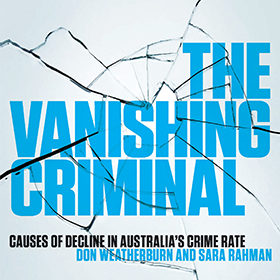
Australians are less likely to be mugged, to have their house broken into or their car stolen than in the last 20 or 30 years, according to two leading criminologists. In a new book titled ‘The Vanishing Criminal’ Don Weatherburn and Sara Rahman set out to chart and explain the rise and fall in crime in Australia between the mid-1970s and the present day.
Between 1975 and 2000, major crime rates in Australia doubled and, in some cases tripled. Near the peak of the crime epidemic, in 1998, an estimated 534,000 Australian households experienced a break and enter or attempted break and enter, 117,900 had their vehicle stolen, 79,100 experienced a robbery, 618,300 were assaulted and 30,100 were sexually assaulted.
By 2000, Australia had the highest rate of burglary and contact crime (assault, sexual assault and robbery) and the second highest rate of motor vehicle theft among the 25 countries included in the international crime victim survey (which includes the United States, Canada, the United Kingdom and most western European countries).
The first sign of change emerged late in 2000, when the price of heroin in Sydney suddenly soared and its purity fell from 80 per cent to around 20 per cent. In one year, the fatal heroin overdose rate fell by 60 per cent.
As heroin overdoses fell, so, too, did rates of robbery, household and business break-ins, motor vehicle theft and most other theft offences. Crime rates in other States and Territories soon followed suit.
By 2017, the Australian robbery rate had fallen by 71 per cent, home break-ins had fallen by 68 per cent, vehicle thefts had fallen by 70 per cent and general theft fell by 43 per cent. By 2017, the homicide rate was about half what it was in the 1980s. Assault was also coming down.
The authors assess 16 different explanations for the fall in crime, including the advent of legalised abortion; the introduction of unleaded petrol; population aging; improvements in psychiatric treatment; the appointment of more police; and the imposition of tougher penalties.
They conclude that the fall in crime was precipitated by a rapid decline in heroin use but then sustained and deepened by a range of other factors, including a decline in the price of portable consumer goods, the rise in electronic funds transfer, population aging; the establishment of a national DNA database and improvements in policing.
The authors are careful to point out, however, that the news on crime is not all good. Some offences, such as fraud, identity theft and methamphetamine trafficking, have risen dramatically. Others, such as sexual offences and domestic violence, show no sign of declining. Robbery, which had fallen dramatically, has recently started rising.
Further enquiries:
Professor Don Weatherburn Ph. 0409 021 127. Email: d.weatherburn@unsw.edu.au . Book orders: Sarah Valle Publicist, Melbourne University Publishing, P (03) 8344 0363 E valle.s@unimelb.edu.au
